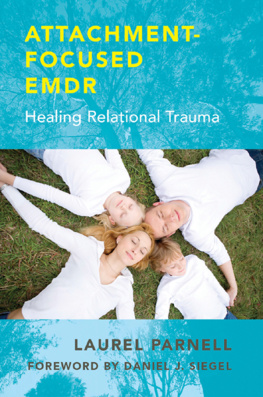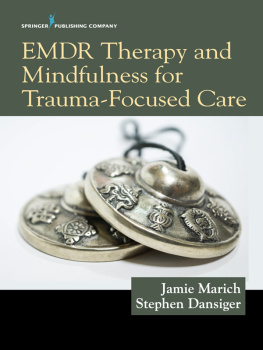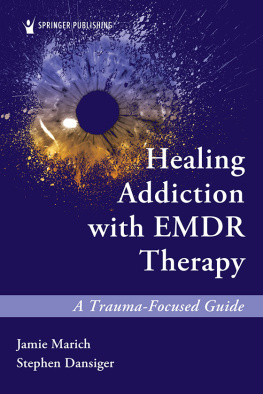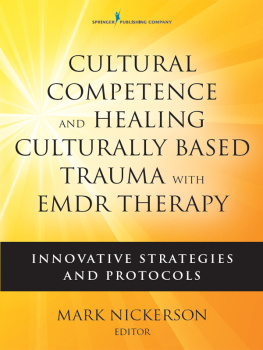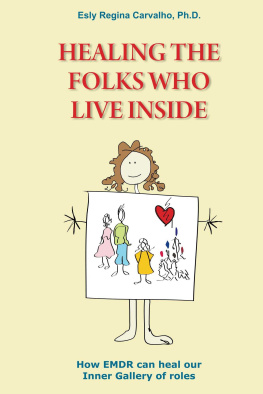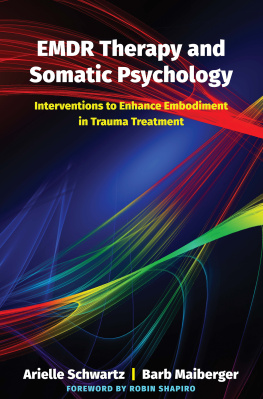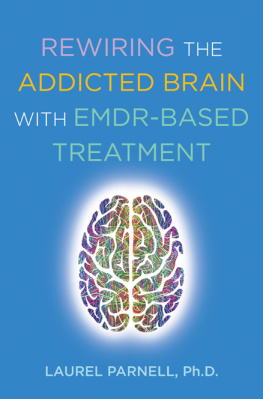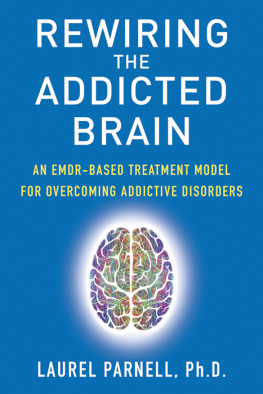
There are so many people I want to thank who have made this book possible. First of all, I want to thank all of the clients with whom I have worked over the years and those who so graciously provided their case material for inclusion in this book. All of these amazing individuals have contributed, through their courage and strength, to my understanding that it is possible to heal even the most unspeakable traumas and neglect. Thank you all from the bottom of my heart. With your contributions to this book, therapists and clients will have new hope for healing that for which there was previously so little remedy.
Special thanks to the three major contributors to this volume: Holly Prichard, Elena Felder, and Rachel Howard, all outstanding EMDR therapists who through their compassion, understanding of what is most important to heal attachment, and excellent clinical skills, beautifully illustrated for readers what attachment-focused EMDR looks like in clinical practice. Thank you also to the talented EMDR therapists Prabha Milstein and Nancy Ewing, whose case material on the development of the ideal mother and the repair of development deficits using imagination and BLS showed their creativity, attunement, and skillful application of this model in their clinical work.
I want to thank Daniel Siegel for his beautiful foreword to this book and for being such an important influence on my understanding of interpersonal neurobiology. His teaching has had a profound effect on the way I think about attachment and approach my clinical work. Not only is he an excellent teacher, but he demonstrates what he is teaching through the kindness, attunement, presence, and compassion in all his interactions.
I want to acknowledge Bessel van der Kolk for his invaluable contribution to my clinical work and teaching. A tireless educator, he has helped expand therapists understanding of the effects of trauma on the brain, and of how to integrate this information into treatment.
I deeply appreciate Francine Shapiro, originator of this powerful therapy that has transformed my life and that of thousands of others.
I wish to acknowledge Allan Schore, who has taught me a great deal about attachment trauma and what is most important in its healing.
Thank you to Deborah Malmud, director of Norton Professional Books, for recognizing the value of this book, and to Sophie Hagen and Margaret Ryan for their excellent eye for detail and helpful suggestions in the line editing.
I appreciate my friend and colleague Maggie Phillips, who has made major contributions to the field of attachment, resource development, complex trauma, ego state work, and pain management.
Thank you to Diana Fosha, who added new ideas to how healing moments in the therapeutic relationship could be made explicit and tapped in as resources. Her AEDP is a major contribution to the field of attachment repair therapies.
I want to extend special thank-yous to my EMDR friends and colleagues, all of whom practice attachment-focused EMDR and are important resources for me personally and professionally: Harriet Sage, Susan Tieger, Alison Teal, Erika Masak-Goldman, Nancy Bravman, Pat Gallagher, Leah Leatherbee, Bruce Patterson, Sean Frankino, Ruth Ehrenkranz-Strauss, Linda Kocienewski, Sandy Shapiro, Caryn Markson, Debbe Davis, Rachel Howard, Susan Curry, John Prendergast, Dinah Weisberg-Tarah, and Meg Grundy. I want to acknowledge as well all of the talented EMDR therapists who have contributed to the growth and development of EMDR over the years; I also acknowledge the therapists, researchers, and authors who have added to our understanding of how an attachment orientation can be integrated into treatment of relational trauma.
I want to thank and acknowledge my dear friend Nischala Devi who has been with me through many ups and downs and whose friendship is one of my most precious resources.
I want to acknowledge my sons, Catono Perez and Etienne Perez-Parnell, and my parents, Helen McDonald and J. Dean Parnell, who I love dearly.
Wondrously, the writing of this book coincided with the birth and first two years of life of my granddaughter Katya, a special synchronicity. I am deeply grateful to Elena Kudryavtseva, Katyas mother, who has shown me that the love for ones baby is instinctual, and that the mother-infant bond can develop in a healthy way, even if the mother has had no experience of such a healthy relationship herself.
I am deeply grateful for my husband Pierre Antoine Blais, who has supported and loved me now for over twenty years and has taught me how a loving relationship can heal relational trauma.
The Evolution of EMDR and Its Clinical Applications
E MDR was originally developed by Francine Shapiro to treat posttraumatic stress disorder (PTSD), particularly single-incident PTSD, with a population from Silicon Valley, California, a primarily educated group of clients. At the closing of my original training Dr. Shapiro instructed us all to make it our own. She told us that it was in our hands. She also told us that EMDR is not a cookie cutter, meaning it is not meant to be used the same way with each person. Taking her instructions to heart, I began to find what worked and what didnt work with my clients. At the time of the training I was already an experienced psychotherapist with a decade of practice accrued. I have always worked with complex trauma, as well as with clients from divergent cultures and backgrounds. My early clinical work was in community mental health clinics working with a Spanish-speaking population. Many of the clients I have worked with experienced severe childhood sexual and physical abuse. I found early on that the standard protocol needed to be modified for these clients. I wrote about work with this population in my second book, EMDR in the Treatment of Adults Abused as Children (Parnell, 1999), which Francine Shapiro endorsed. Although she agreed that the procedural steps could be modified according to the needs of the clients, it was important to her that clinicians understand the rationale for the modifications and not just discard the protocol altogether. I agree with her on this. I believe it is important for therapists to understand the rationale for each of the steps in the EMDR protocol, and then to modify it intelligently. This is the stance I teach in all of my trainings, which I believe is respectful to the clinicians as well as to the intention of EMDR as it was originally designed.
EMDR as defined by Shapiro (1995, 2001) is an eight-phase model of treatment. Most therapists, aside from those of us who teach this or are on EMDR International Association (EMDRIA) committees, do not remember these phases. Thats because they do not make a lot of sense. For example, history taking and preparation, phases 1 and 2, may not be sequential and may take days to months to accomplish, whereas installation and body scan, phases 5 and 6, may take only a few minutes. Most trauma therapies describe three phases of treatmentphases that are reasonable and are easy to conceptualize.
For many clients with severe childhood trauma suffering from complex PTSD, therapy may proceed over three phases. I described these phases in detail in EMDR in the Treatment of Adults Abused as Children (Parnell, 1999) and in A Therapists Guide to EMDR (Parnell, 2007). Here I summarize them. The beginning phase includes assessment, preparation, and ego-strengthening (Shapiros phases 1 and 2 of history taking and preparation). In this phase clients are assessed for appropriateness of the treatment and sufficiently stabilized; resources are developed and installed; the therapeutic relationship is well established; and coping skills are learned. The therapeutic container must be strong enough, which means that clients need to feel sufficiently safe with the therapist and be able to tolerate high levels of affect prior to beginning intensive trauma work. In the
Next page
